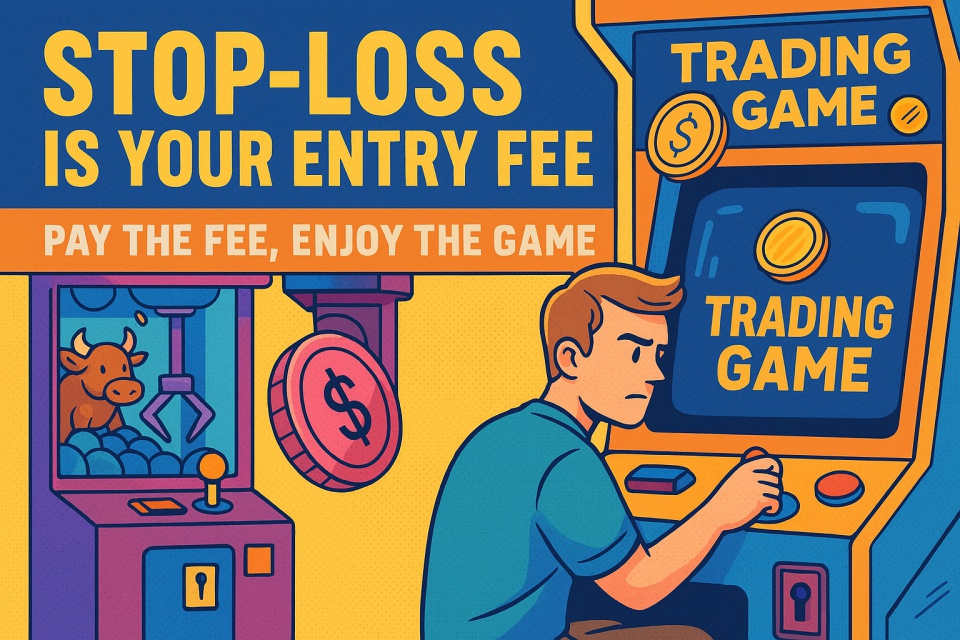🎮 Introduction: Trading Isn’t Free—And That’s Okay
Most traders want one thing: profit.
And most traders fear one thing: loss.
It’s a natural instinct—to chase reward and avoid pain. But in the world of FX trading, this mindset can become a trap. When we treat every stop-loss as a personal failure, we begin to fear the market. We hesitate. We overthink. We lose not just money, but confidence.
But what if we looked at it differently?
What if we viewed a stop-loss not as a mistake,
but as the price of playing the game?
💸 Section 1: Stop-Loss = Participation Fee, Not Failure
Imagine stepping into an arcade.
You drop a coin into the machine—not to win a prize right away, but to enjoy the game.
Sometimes you win.
Sometimes you lose.
But either way, you’re paying for the chance to play.
Trading is no different.
When you enter a position, you’re not guaranteed a payout. You’re paying for the experience—the opportunity to test your strategy, your discipline, and your mindset in a live environment.
Just like arcade games, each trade has a price:
🎯 The stop-loss is your entry fee.
And just like in an arcade, there are people who win consistently—not because they never lose, but because they understand the mechanics of the game.
👾 Section 2: Arcade Game Analogy — What FX Traders Can Learn
Let’s say you’re playing a claw machine at an arcade.
You insert a coin, aim for a plush toy, and the claw almost grabs it—but slips.
You didn’t win this time, but you don’t walk away thinking:
“I’m a failure.”
“I’m stupid.”
“I should never play again.”
Instead, you laugh.
You analyze.
Maybe you try again—this time with a better angle or more patience.
💡 Now apply this to your trades.
Many FX traders beat themselves up after a stop-loss hits.
They question their intelligence, their skill, or even their worth.
But in truth, that stop-loss is just like the coin you dropped into the game.
It bought you a round of real-time decision-making, pattern recognition, and psychological exposure.
What separates seasoned traders from beginners isn’t just strategy.
It’s the ability to detach ego from outcome—to see each trade as one round of many.
🎮 If you treat trading like an arcade game, you’ll stop fearing loss…
and start enjoying the process of mastering it.
🧠 Section 3: Mindset Shift — Why Loss Doesn’t Equal Stupidity
Many traders fall into the trap of over-identifying with their outcomes.
A winning trade means “I’m smart.”
A losing trade? “I’m dumb.” “I’m bad at this.” “Maybe I should quit.”
But this mindset is not only harsh—it’s inaccurate.
Markets aren’t a test of intelligence.
They’re a reflection of probabilities, structure, and discipline.
Even the best traders in the world take losses—regularly.
What sets them apart isn’t avoiding loss…
It’s how they respond to it.
Let’s be clear:
- A loss does not mean you’re stupid.
- A loss does not mean your system is broken.
- A loss does not mean your trading career is doomed.
It simply means the market didn’t go your way this time.
If you’ve defined your risk in advance, followed your plan, and honored your stop—
you did everything right.
The real mistake?
Letting your self-worth rise and fall with every pip.
🧘♂️ When you decouple your identity from your results,
you free yourself to trade with clarity and confidence.
📈 Section 4: Structure Your Trades Like a Game You Paid For
Imagine you’re about to play a challenging game at the arcade.
It costs 100 yen to play.
Would you just mash buttons randomly, hoping to win?
Of course not.
You’d study the mechanics.
Watch how others play.
Form a strategy before committing that coin.
💡 This is exactly how you should approach your trades.
Before entering a position, ask yourself:
- 🎯 What’s the goal of this trade?
- 🛑 Where is the stop-loss, and why there?
- 💰 Where is the take-profit, and is it worth the risk?
- ⚖️ Does the risk-reward ratio make structural sense?
When you plan this way, you stop thinking of trades as “bets.”
You start treating them as structured engagements—like calculated moves in a game.
And when your stop-loss is hit?
That’s not failure.
It’s the cost of entry.
You paid to test your edge—and next round, you’ll be sharper.
📌 Think of every trade as a practice run in mastering the market’s logic.
Each “loss” is just data that improves your gameplay.
📘 Final Thoughts: Make Peace with Losses to Grow
If you’re serious about growing as a trader, you need to let go of one toxic belief:
“Losses mean I’m doing something wrong.”
In reality, losses are baked into the business.
They’re not a detour from success—they’re part of the road.
When you accept that every stop-loss is a participation fee—
like 100 yen to play a game—you begin to:
- Trade with more emotional clarity
- Focus on execution, not perfection
- Respect the market, rather than fear it
🎮 Every coin dropped in an arcade teaches you something.
So does every trade.
Even the failed ones.
Some people treat trading like a job. Others, like a gamble.
But the most resilient traders treat it like a game they’re committed to mastering—
where every level (win or lose) makes them stronger.
So the next time you take a loss, don’t flinch.
Just whisper to yourself:
“That was my 100-yen round.”
“Let’s see what I learn from this one.”
And keep playing.


